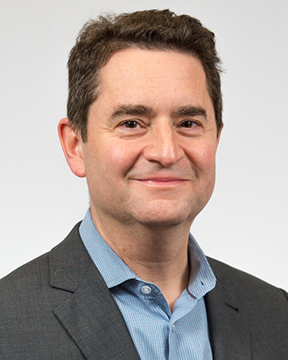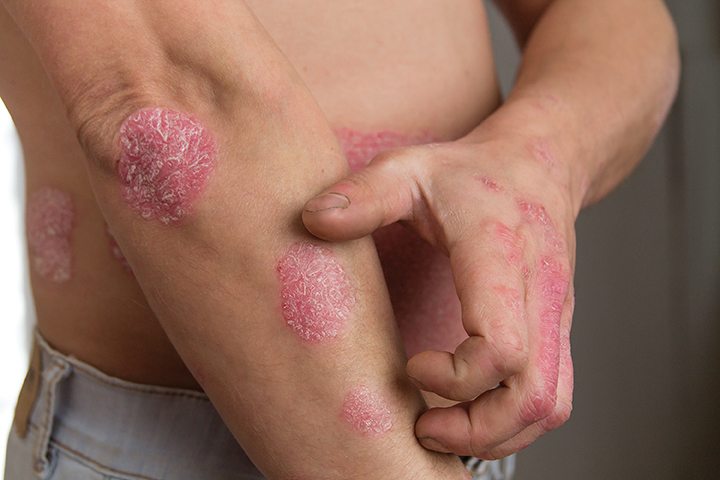By Bob Kronmeyer | Reviewed by Bruce Strober, MD, PhD
Two biologics in late-stage clinical development are a welcome addition to the armamentarium for treating moderate-to-severe plaque psoriasis: bimekizumab (UCB) and mirikizumab (Eli Lilly and Company).
Bimekizumab

“Bimekizumab has a novel mechanism of action,” Bruce Strober, MD, PhD, a Clinical Professor of Dermatology at Yale University, told The Dermatology Digest. “The drug inhibits not only interleukin 17A (IL-17A), but also interleukin 17-F (IL-17F), thus becoming the first drug that employs this approach to control psoriasis and psoriatic arthritis. It appears that both isoforms of IL-17 are relevant to psoriasis pathophysiology.”
As a result, bimekizumab appears to have greater efficacy than all previous medications used for psoriasis, according to Dr. Strober, who suspects the drug will be FDA-approved by the end of 2021.
Bimekizumab is an investigational humanized monoclonal immunoglobulin G (Ig) antibody (subclass IgG1) that selectively inhibits both IL-17A and IL-17F, which are 2 critical cytokines driving inflammatory processes.
The selective inhibition of both IL-17F and IL-17A suppresses inflammation to a greater degree than IL-17A inhibition alone.
The ideal patient for bimekizumab is without pre-existing inflammatory bowel disease (IBD), which is a contraindication for all drugs that block the IL-17 pathway. It also suitable for patients who also have psoriatic arthritis.
“It appears from phase 2 studies that bimekizumab is very good for the joints and ligaments,” Dr. Strober said.
Separate phase 3 studies of bimekizumab have compared the pending drug to 2 well-established drugs: ustekinumab (Stelara) and adalimumab (Humira Pen). “Not only does bimekizumab achieve profound efficacy in its own right, but it also has significantly better efficacy than these 2 well-known biologics,” Dr. Strober said.
Study results
Last June, UCB presented data from the Phase 3 clinical development program of bimekizumab during a virtual session of the American Academy of Dermatology (AAD) 2020 Annual Meeting. The data showed that the drug resulted in skin clearance superior to placebo and ustekinumab at week 16 in adults with moderate-to-severe plaque psoriasis.
The 2 studies also demonstrated rapid response after 1 dose and durability of response up to 1 year.
In BE VIVID, the pivotal Phase 3 study with active comparator ustekinumab, patients treated with bimekizumab 320 mg every 4 weeks achieved significantly superior skin clearance than those receiving placebo or ustekinumab at week 16.
At 16 weeks, 58.6% of bimekizumab patients achieved Psoriasis Area and Severity Index (PASI) 100 versus 20.9% of ustekinumab patients. PASI 90 rates were 85.% for bimekizumab, 49.7% for ustekinumab, and 4.8% for placebo.
In addition, Investigator Global Assessment (IGA) rates of 0 or 1 were 84.1% for bimekizumab, 53.4% for ustekinumab, and 4.8% for placebo.
For patients who received 1 dose of bimekizumab, 76.9% attained PASI 75 by week 4, compared to only 15.3% of ustekinumab patients and 2.4% of placebo patients.
A significantly greater proportion of bimekizumab patients also achieved IGA 0/1 and PASI 90 at week 52 compared to ustekinumab: 77.9% vs. 60.7% and 81.6% vs. 55.8%, respectively (P < 0.001).
The most frequently reported adverse events with bimekizumab through week 52 in the study were nasopharyngitis (21.8%), oral candidiasis (15.2%) and upper respiratory tract infections (9.1%).
However, the majority of adverse events were mild to moderate in intensity, and 94.7% of patients continued treatment.
In BE READY, the pivotal Phase 3 randomized withdrawal study, participants were randomized to bimekizumab 320 mg every 4 weeks or placebo for the first 16 weeks.
Bimekizumab was superior to placebo in achieving PASI 90 and IGA 0/1 at week 16. Specifically, 90.8% of the drug group attained PASI 90 compared to 1.2% of the placebo group. Likewise, 92.6% of bimekizumab patients attained IGA 0/1 vs 1.2% of placebo patients, and 68.2% of bimekizumab patients achieved PASI 100 compared to 1.2.% of placebo patients.
Dosing regimens and side effects
In the second phase of the BE READY study, patients who had achieved at least a PASI 90 response at week 16 were re-randomized to receive continuous bimekizumab at 2 different dosing regimens (320 mg every 4 weeks or 320 mg every 8 weeks) or withdrawn from treatment (placebo every 4 weeks).
Maintenance of response was comparable in the 2 bimekizumab treatment arms. Overall, 86.8% of patients who received continuous bimekizumab 320 mg every 4 weeks maintained PASI 90 at week 56, compared to 91% who were switched to bimekizumab 320 mg every 8 weeks and to only 16.2% of patients who were withdrawn.
In its initial induction period, bimekizumab will likely be given once every 4 weeks, until week 16, according to Dr. Strober, followed by probably once every 8 weeks. “However, there is a possibility that it will be an every-4-week drug indefinitely,” Dr. Strober said. “But this has yet to be decided by the FDA.”
Additionally, bimekizumab demonstrates a quick early response. “The drug has a rapid onset of action, so patients will clear perhaps more quickly on bimekizumab than any other previous drug we have used,” Dr. Strober said.
The best approved drugs for psoriasis have achieved a PASI 90 70% to 75% of the time, according to Dr. Strober, whereas bimekizumab seems to achieve PASI 90 80% to 90% of the time. “At the PASI 90 level, this is roughly a 10% to 15% absolute increase in efficacy over our previous drugs, such as ixekizumab (Taltz) risankizumab (Skyrizi) and guselkumab (Tremfya),” said Dr. Strober.
The 1 known downside of bimekizumab is that approximately 15% to 20% of patients develop candidiasis, mostly of the oral mucosa. “But this adverse event appears to be mild in most patients who experience it,” Dr. Strober said. “Most of these patients also stayed in the study and continued to receive medication.”
Nonetheless, the candidiasis will sometimes need to be managed by clinicians. “The management of this adverse event is still being defined and characterized,” Dr. Strober said. “Ultimately, we are going to learn as a specialty how to successfully manage patients who have this adverse event and keep them on drug the majority of the time. But overall, bimekizumab is a very safe drug,” he said.
Still, Dr. Strober anticipates that bimekizumab might not be avidly adopted because of the new mechanism of action and the adverse event of candidiasis. “These concerns could inhibit some prescribers,” he said. “Payer restrictions may also play a large role in disallowing this drug to be quickly adopted as a first-line therapy.”
Over time, though, Dr. Strober believes bimekizumab will become a popular drug because of its efficacy for both psoriasis and psoriatic arthritis.
“The drug should eventually climb toward the top of provider treatment choices.”
“With bimekizumab, we always need to remember that drugs that block the IL-17 pathway treat not only the skin but also the arthritis component. This might be a major differentiation point when choosing a biologic agent. About one-third of psoriasis patients have both the skin disease and the accompanying joint disease.”
Mirikizumab
In contrast to bimekizumab, mirikizumab is not a novel mechanism of action, but rather an interleukin 23 (IL-23) inhibitor. The drug is a humanized IgG4 monoclonal antibody that binds to the p19 subunit of IL-23.
“To my eye, the drug has data that does not make it superior to our current IL-23 inhibitors,” Dr. Strober said. “So I am less excited by it.”
In addition, mirikizumab dosing likely involves an induction period of every 4 weeks through 16 weeks, followed by dosing every 8 weeks during its maintenance phase, “which is neither novel nor long for an IL-23 inhibitor,” he said. “In fact, the IL-23 inhibitor risankizumab is given once every 12 weeks in its maintenance period and may even work better than mirikizumab.”
Mirikizumab should become available shortly after bimekizumab, according to Dr. Strober, either late 2021 or during 2022, and encompasses a similar ideal patient population as bimekizumab.
Last July, Eli Lilly shared results of the multicenter OASIS-2 study that evaluated mirikizumab vs secukinumab (Cosentyx) and placebo in patients with moderate-to-severe plaque psoriasis.
The study randomized 1465 patients in a 4:4:4:1 ratio to 1 of 4 induction and maintenance period treatments: 250 mg mirikizumab at weeks 0, 4, 8, and 12, followed by 250 mg every 8 weeks starting at week 16; 250 mg mirikizumab at weeks 0, 4, 8, and 12, followed by 125 mg every 8 weeks starting at week 16; 300 mg secukinumab at weeks 0, 1, 2, 3, and 4, followed by 300 mg every 4 weeks starting at week 4; and placebo at weeks 0, 4, 8, and 12, followed by 250 mg mirikizumab every 4 weeks starting at week 16 through week 32, followed by every 8 weeks thereafter.
Dosing was via subcutaneous injection for all treatments.
Study results and side effects
The study concluded that mirikizumab was superior to placebo and non-inferior to secukinumab at week 16, as well as being superior to secukinumab at week 52.
The 2 most common treatment-emergent adverse events occurring in at least 5% of patients during the induction period of up to 16 weeks were nasopharyngitis and upper respiratory infections, whereas during the combined induction and maintenance treatment periods of up to 52 weeks, the notable adverse events were nasopharyngitis, upper respiratory tract infections, headache, back pain, and arthralgia.
The frequency of serious adverse events was comparable across treatment arms: less than 2.5% during the induction period and less than 6% during combined induction and maintenance periods up to 52 weeks.
Despite favorable study results, Dr. Strober currently does not envision many scenarios in which a dermatologist would choose mirikizumab over other drugs in its class, such as risankizumab and guselkumab. One additional influencing factor is payer access.
Mirikizumab might also treat psoriatic arthritis, “but this effect has yet to be defined,” he said.
Dr. Strober noted that the options to treat psoriasis are expanding. “The broad palette of choices, while increasingly complex and confusing for prescribers, is a great benefit to patients who need more options,” he said.
Disclosures
Dr. Strober reports the following financial disclosures:
Consultant (honoraria): AbbVie, Almirall, Amgen, Arcutis, Arena, Aristea, Boehringer Ingelheim, Immunic Therapeutics, Bristol-Myers-Squibb, Connect Biopharma, Dermavant, Dermira, Equillium, Janssen, Leo, Eli Lilly, Meiji Seika Pharma, Mindera, Novartis, Pfizer, GlaxoSmithKline, UCB Pharma, Sun Pharma, Ortho Dermatologics, Regeneron, Sanofi-Genzyme
Speaker: AbbVie, Amgen, Eli Lilly, Janssen, Sanofi-Genzyme
Co-Scientific Director (consulting fee): Corrona Psoriasis Registry
Investigator: Dermavant, AbbVie, Corrona Psoriasis Registry, Dermira, Cara, Novartis
Editor-in-Chief (honorarium): Journal of Psoriasis and Psoriatic Arthritis


